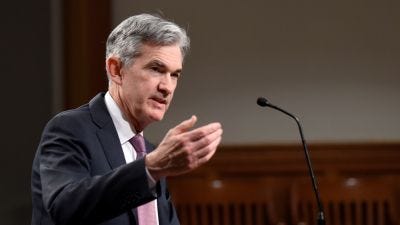
Major U.S. stock indexes closed mostly higher Wednesday after the Federal Reserve cut its benchmark interest rate for a second time this year, citing slowing global economic growth and uncertainty over U.S. trade conflicts.
Gains in banks, utilities and technology companies outweighed losses elsewhere in the market, which had been broadly lower until the last hour of trading. Bond yields moved lower.
Stocks initially declined after the central bank announced the widely expected rate cut. Its policy statement failed to indicate whether more rate cuts were likely this year, though the central bank left the door open for additional rate cuts if the economy weakens.
“We’re not on a preset course,” Fed Chairman Jerome Powell said in an afternoon press conference.
Even so, diverging opinions within the members of the Fed’s policymaking committee left some investors feeling uneasy about what the Fed may do next.
“The (Fed) cut rates, as expected, but the quantity and necessity of future rate cuts were called into question,” Sam Stovall, chief investment strategist at CFRA, wrote in a research note.
The S&P 500 index inched 1.03 points higher, or less than 0.1%, to 3,006.73. The benchmark index is now within 0.7% of its all-time high set in July.
The Dow Jones Industrial Average rebounded after being down most of the day, adding 36.28 points, or 0.1%, to 27,147.08. The Nasdaq slid 8.62 points, or 0.1%, to 8,177.39.
The Russell 2000 index of smaller company stocks bore the brunt of the selling, dropping 9.95 points, or 0.6%, to 1,568.34.
The Fed is trying to combat threats to the U.S. economy, including uncertainties caused by President Donald Trump’s trade war with China, slower global growth and a slump in American manufacturing.
Investors largely expected the Fed to cut short-term interest rates by another quarter of a percentage point, following a similar cut in late July. The rate, which is now at a range of 1.75% to 2%, influences many consumer and business loans.
A look at how each of the central bank’s policymakers voted offered few clues as to the likelihood of further rate cuts.
Fed officials approved the rate cut 7-3, with two officials preferring to keep rates unchanged and one arguing for a bigger half-point cut. It was the most Fed dissents in three years. The policy committee also remains split on whether rates should be a quarter-point lower, higher or the same as they are now by the end of this year.
The divisions among Fed officials underscore the challenges confronting Powell in guiding the Fed at time of high uncertainty in the U.S. economy. They also fuel doubts among investors looking for certainty on interest rate policy.
Free? Comcast looks to bolster its Xfinity Flex devices by giving them away for free
“The Fed didn’t say a lot that was new, but there are some people who were just holding on and hoping against hope that there would be some kind of dovish surprise, and there wasn’t,” said Sameer Samana, senior global market strategist at Wells Fargo Investment Institute.
The broader market has been wobbling this week and is so far on track for a slight weekly loss after three consecutive weeks of gains. Those gains came as both sides in the U.S.-China trade war took steps to ease tensions ahead of planned negotiations in October.
But, the volatility has been taking its toll. The S&P 500 is eking modest gains of 2.2% for the quarter with just a few weeks left. That marks a pullback from gains of 3.8% in the second quarter and a notable deceleration from the 13.1% rise during the first quarter.
Bond prices rose and the yield on the 10-year Treasury fell to 1.80% from 1.81% late Tuesday. Investors typically shift money into bonds when they grow more concerned about the economy’s health.
Financial stocks recovered from an early slide. JPMorgan gained 1% and Citigroup rose 0.9%.
A disappointing drop in quarterly profit weighed on FedEx shares, which tumbled 12.9%, making it the biggest decliner in the S&P 500. The package delivery giant also cut its full-year forecast.
Adobe fell 1.8% after giving investors a weak profit forecast.
Chewy slid 6.1% to $28.39 after the online pet store’s fiscal second quarter loss was far wider than Wall Street had expected. The company debuted on the New York Stock Exchange in June at $22 per share and closed at $34.99 on its first day.
Major stock indexes in Europe closed mostly higher. Asian stocks ended mixed.
Oil prices continued pulling back from a 14% spike on Monday as Saudi Arabia brings back production at an oil facility attacked over the weekend. Benchmark U.S. crude fell $1.23 to settle at $58.11 per barrel. Brent crude, the international standard, dropped 95 cents to close at $63.60.
Wholesale gasoline fell 2 cents to $1.66 per gallon. Heating oil declined 2 cents to $1.97 per gallon. Natural gas fell 3 cents to $2.64 per 1,000 cubic feet.
Gold rose $2.40 to $1,507.50 per ounce, silver fell 22 cents to $17.80 per ounce and copper fell 1 cent to $2.60 per pound.
The dollar rose to 108.35 Japanese yen from 108.20 yen on Tuesday. The euro weakened to $1.1032 from $1.1066.

